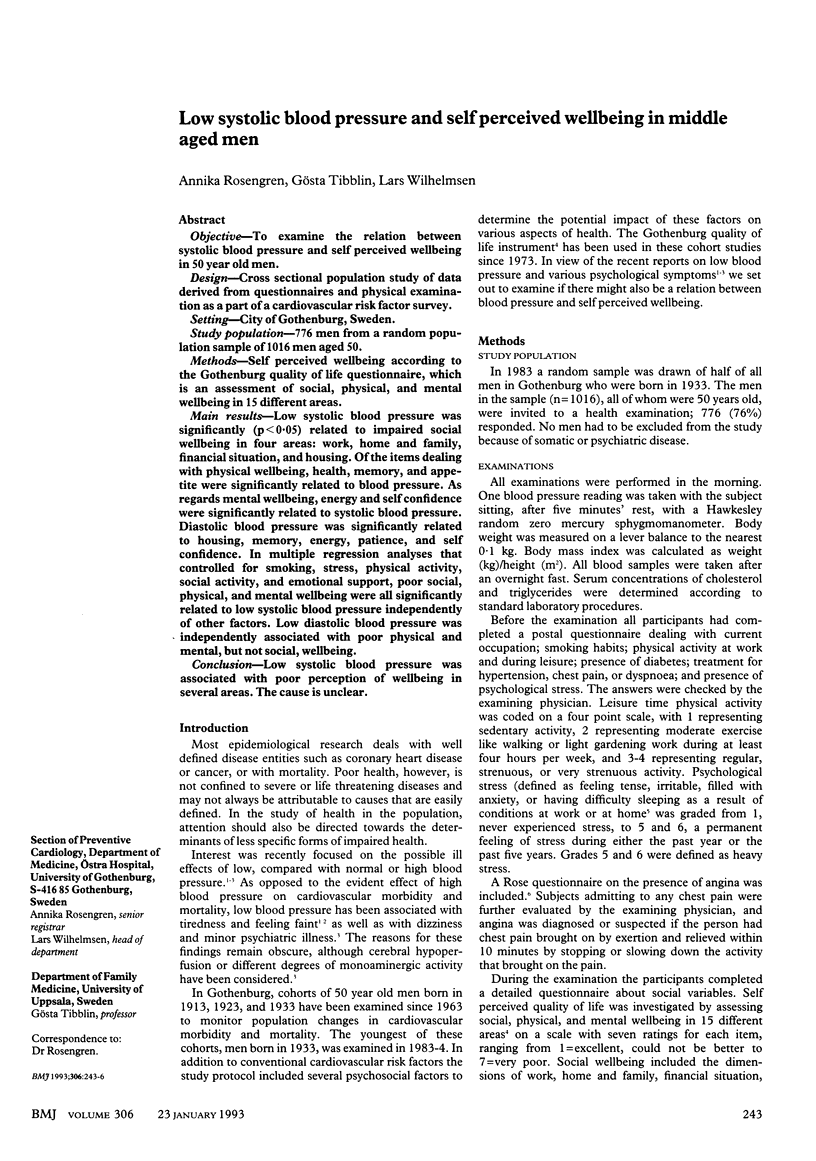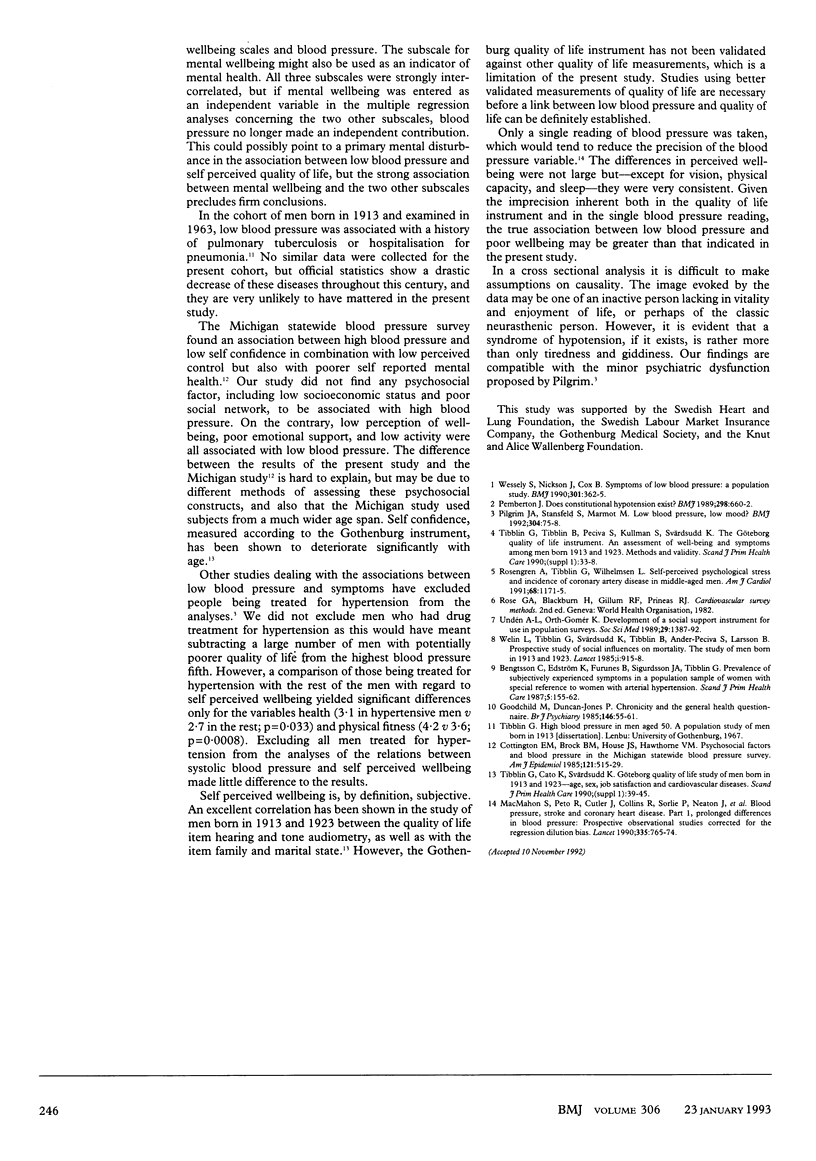Abstract
OBJECTIVE--To examine the relation between systolic blood pressure and self perceived wellbeing in 50 year old men. DESIGN--Cross sectional population study of data derived from questionnaires and physical examination as a part of a cardiovascular risk factor survey. SETTING--City of Gothenburg, Sweden. STUDY POPULATION--776 men from a random population sample of 1016 men aged 50. METHODS--Self perceived wellbeing according to the Gothenburg quality of life questionnaire, which is an assessment of social, physical, and mental wellbeing in 15 different areas. MAIN RESULTS--Low systolic blood pressure was significantly (p < 0.05) related to impaired social wellbeing in four areas: work, home and family, financial situation, and housing. Of the items dealing with physical wellbeing, health, memory, and appetite were significantly related to blood pressure. As regards mental wellbeing, energy and self confidence were significantly related to systolic blood pressure. Diastolic blood pressure was significantly related to housing, memory, energy, patience, and self confidence. In multiple regression analyses that controlled for smoking, stress, physical activity, social activity, and emotional support, poor social, physical, and mental wellbeing were all significantly related to low systolic blood pressure independently of other factors. Low diastolic blood pressure was independently associated with poor physical and mental, but not social, wellbeing. CONCLUSION--Low systolic blood pressure was associated with poor perception of wellbeing in several areas. The cause is unclear.
Full text
PDF



Selected References
These references are in PubMed. This may not be the complete list of references from this article.
- Bengtsson C., Edström K., Furunes B., Sigurdsson J. A., Tibblin G. Prevalence of subjectively experienced symptoms in a population sample of women with special reference to women with arterial hypertension. Scand J Prim Health Care. 1987 Sep;5(3):155–162. doi: 10.3109/02813438709013997. [DOI] [PubMed] [Google Scholar]
- Cottington E. M., Brock B. M., House J. S., Hawthorne V. M. Psychosocial factors and blood pressure in the Michigan Statewide Blood Pressure Survey. Am J Epidemiol. 1985 Apr;121(4):515–529. doi: 10.1093/oxfordjournals.aje.a114029. [DOI] [PubMed] [Google Scholar]
- Goodchild M. E., Duncan-Jones P. Chronicity and the General Health Questionnaire. Br J Psychiatry. 1985 Jan;146:55–61. doi: 10.1192/bjp.146.1.55. [DOI] [PubMed] [Google Scholar]
- MacMahon S., Peto R., Cutler J., Collins R., Sorlie P., Neaton J., Abbott R., Godwin J., Dyer A., Stamler J. Blood pressure, stroke, and coronary heart disease. Part 1, Prolonged differences in blood pressure: prospective observational studies corrected for the regression dilution bias. Lancet. 1990 Mar 31;335(8692):765–774. doi: 10.1016/0140-6736(90)90878-9. [DOI] [PubMed] [Google Scholar]
- Pemberton J. Does constitutional hypotension exist? BMJ. 1989 Mar 11;298(6674):660–662. doi: 10.1136/bmj.298.6674.660. [DOI] [PMC free article] [PubMed] [Google Scholar]
- Pilgrim J. A., Stansfeld S., Marmot M. Low blood pressure, low mood? BMJ. 1992 Jan 11;304(6819):75–78. doi: 10.1136/bmj.304.6819.75. [DOI] [PMC free article] [PubMed] [Google Scholar]
- Tibblin G., Cato K., Svärdsudd K. Göteborg quality of life study of men born in 1913 and 1923--age, sex, job satisfaction and cardiovascular diseases. Scand J Prim Health Care Suppl. 1990;1:39–45. [PubMed] [Google Scholar]
- Undén A. L., Orth-Gomér K. Development of a social support instrument for use in population surveys. Soc Sci Med. 1989;29(12):1387–1392. doi: 10.1016/0277-9536(89)90240-2. [DOI] [PubMed] [Google Scholar]
- Welin L., Tibblin G., Svärdsudd K., Tibblin B., Ander-Peciva S., Larsson B., Wilhelmsen L. Prospective study of social influences on mortality. The study of men born in 1913 and 1923. Lancet. 1985 Apr 20;1(8434):915–918. doi: 10.1016/s0140-6736(85)91684-8. [DOI] [PubMed] [Google Scholar]
- Wessely S., Nickson J., Cox B. Symptoms of low blood pressure: a population study. BMJ. 1990 Aug 18;301(6748):362–365. doi: 10.1136/bmj.301.6748.362. [DOI] [PMC free article] [PubMed] [Google Scholar]


